Joshua J. Engelsma
Minutiae-Guided Fingerprint Embeddings via Vision Transformers
Oct 26, 2022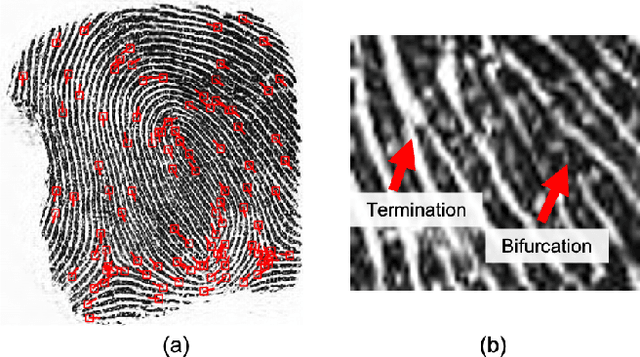
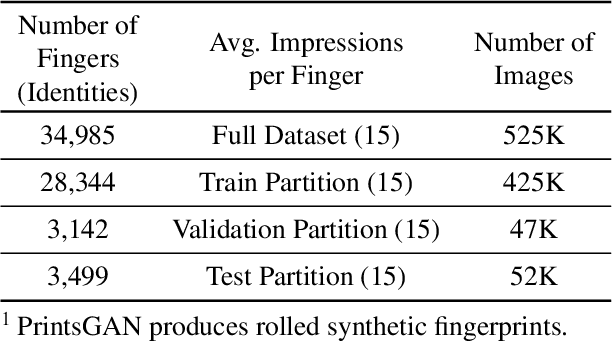
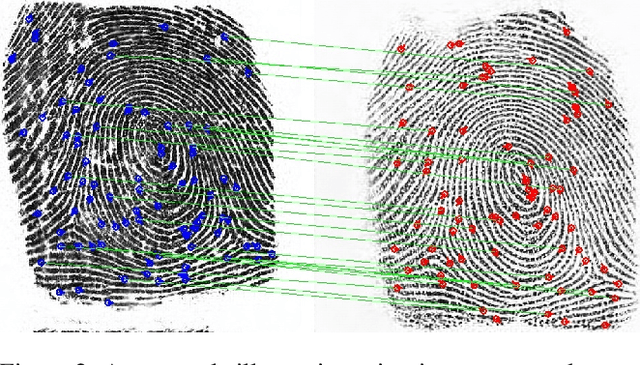

Abstract:Minutiae matching has long dominated the field of fingerprint recognition. However, deep networks can be used to extract fixed-length embeddings from fingerprints. To date, the few studies that have explored the use of CNN architectures to extract such embeddings have shown extreme promise. Inspired by these early works, we propose the first use of a Vision Transformer (ViT) to learn a discriminative fixed-length fingerprint embedding. We further demonstrate that by guiding the ViT to focus in on local, minutiae related features, we can boost the recognition performance. Finally, we show that by fusing embeddings learned by CNNs and ViTs we can reach near parity with a commercial state-of-the-art (SOTA) matcher. In particular, we obtain a TAR=94.23% @ FAR=0.1% on the NIST SD 302 public-domain dataset, compared to a SOTA commercial matcher which obtains TAR=96.71% @ FAR=0.1%. Additionally, our fixed-length embeddings can be matched orders of magnitude faster than the commercial system (2.5 million matches/second compared to 50K matches/second). We make our code and models publicly available to encourage further research on this topic: https://github.com/tba.
PrintsGAN: Synthetic Fingerprint Generator
Jan 20, 2022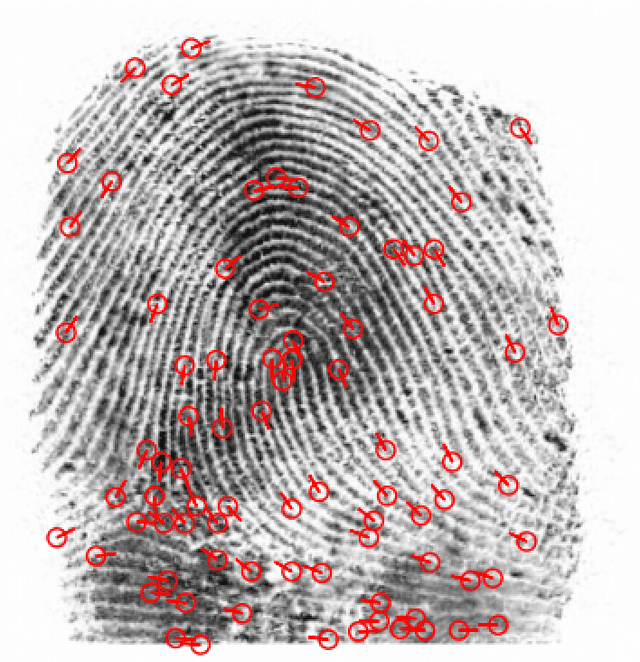
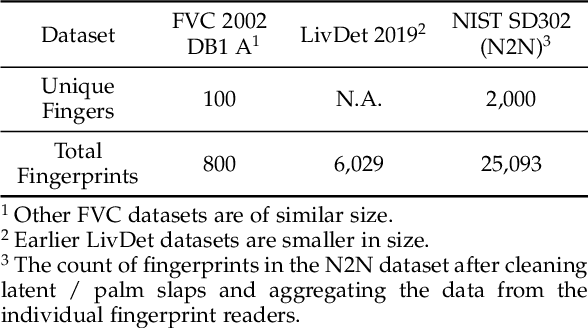


Abstract:A major impediment to researchers working in the area of fingerprint recognition is the lack of publicly available, large-scale, fingerprint datasets. The publicly available datasets that do exist contain very few identities and impressions per finger. This limits research on a number of topics, including e.g., using deep networks to learn fixed length fingerprint embeddings. Therefore, we propose PrintsGAN, a synthetic fingerprint generator capable of generating unique fingerprints along with multiple impressions for a given fingerprint. Using PrintsGAN, we synthesize a database of 525k fingerprints (35K distinct fingers, each with 15 impressions). Next, we show the utility of the PrintsGAN generated dataset by training a deep network to extract a fixed-length embedding from a fingerprint. In particular, an embedding model trained on our synthetic fingerprints and fine-tuned on a small number of publicly available real fingerprints (25K prints from NIST SD302) obtains a TAR of 87.03% @ FAR=0.01% on the NIST SD4 database (a boost from TAR=73.37% when only trained on NIST SD302). Prevailing synthetic fingerprint generation methods do not enable such performance gains due to i) lack of realism or ii) inability to generate multiple impressions per finger. We plan to release our database of synthetic fingerprints to the public.
Biometrics: Trust, but Verify
May 31, 2021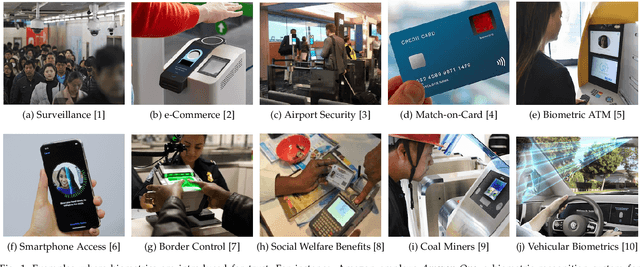
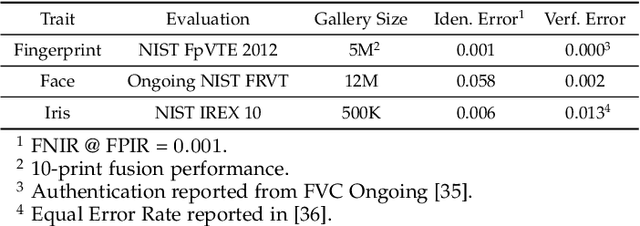
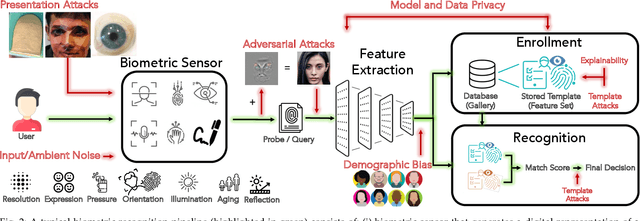
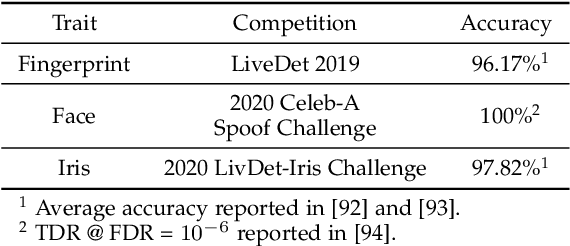
Abstract:Over the past two decades, biometric recognition has exploded into a plethora of different applications around the globe. This proliferation can be attributed to the high levels of authentication accuracy and user convenience that biometric recognition systems afford end-users. However, in-spite of the success of biometric recognition systems, there are a number of outstanding problems and concerns pertaining to the various sub-modules of biometric recognition systems that create an element of mistrust in their use - both by the scientific community and also the public at large. Some of these problems include: i) questions related to system recognition performance, ii) security (spoof attacks, adversarial attacks, template reconstruction attacks and demographic information leakage), iii) uncertainty over the bias and fairness of the systems to all users, iv) explainability of the seemingly black-box decisions made by most recognition systems, and v) concerns over data centralization and user privacy. In this paper, we provide an overview of each of the aforementioned open-ended challenges. We survey work that has been conducted to address each of these concerns and highlight the issues requiring further attention. Finally, we provide insights into how the biometric community can address core biometric recognition systems design issues to better instill trust, fairness, and security for all.
C2CL: Contact to Contactless Fingerprint Matching
Apr 08, 2021



Abstract:Matching contactless fingerprints or finger photos to contact-based fingerprint impressions has received increased attention in the wake of COVID-19 due to the superior hygiene of the contactless acquisition and the widespread availability of low cost mobile phones capable of capturing photos of fingerprints with sufficient resolution for verification purposes. This paper presents an end-to-end automated system, called C2CL, comprised of a mobile finger photo capture app, preprocessing, and matching algorithms to handle the challenges inhibiting previous cross-matching methods; namely i) low ridge-valley contrast of contactless fingerprints, ii) varying roll, pitch, yaw, and distance of the finger to the camera, iii) non-linear distortion of contact-based fingerprints, and vi) different image qualities of smartphone cameras. Our preprocessing algorithm segments, enhances, scales, and unwarps contactless fingerprints, while our matching algorithm extracts both minutiae and texture representations. A sequestered dataset of 9,888 contactless 2D fingerprints and corresponding contact-based fingerprints from 206 subjects (2 thumbs and 2 index fingers for each subject) acquired using our mobile capture app is used to evaluate the cross-database performance of our proposed algorithm. Furthermore, additional experimental results on 3 publicly available datasets demonstrate, for the first time, contact to contactless fingerprint matching accuracy that is comparable to existing contact to contact fingerprint matching systems (TAR in the range of 96.67% to 98.15% at FAR=0.01%).
A Unified Model for Fingerprint Authentication and Presentation Attack Detection
Apr 07, 2021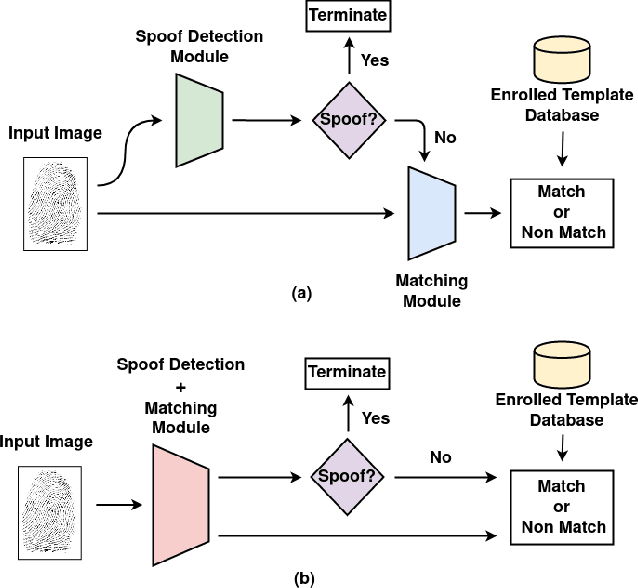

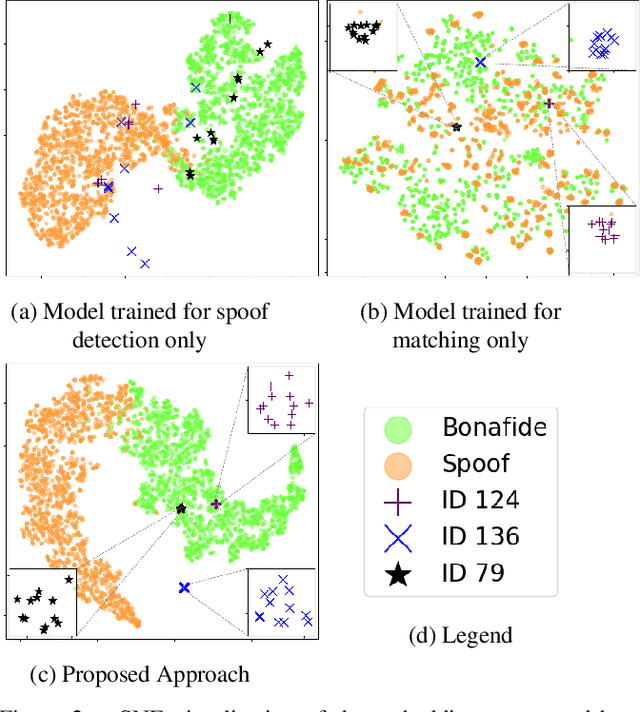
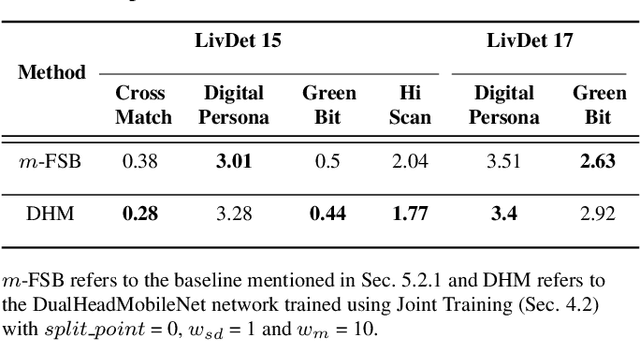
Abstract:Typical fingerprint recognition systems are comprised of a spoof detection module and a subsequent recognition module, running one after the other. In this paper, we reformulate the workings of a typical fingerprint recognition system. In particular, we posit that both spoof detection and fingerprint recognition are correlated tasks. Therefore, rather than performing the two tasks separately, we propose a joint model for spoof detection and matching to simultaneously perform both tasks without compromising the accuracy of either task. We demonstrate the capability of our joint model to obtain an authentication accuracy (1:1 matching) of TAR = 100% @ FAR = 0.1% on the FVC 2006 DB2A dataset while achieving a spoof detection ACE of 1.44% on the LiveDet 2015 dataset, both maintaining the performance of stand-alone methods. In practice, this reduces the time and memory requirements of the fingerprint recognition system by 50% and 40%, respectively; a significant advantage for recognition systems running on resource-constrained devices and communication channels.
Infant-ID: Fingerprints for Global Good
Oct 07, 2020
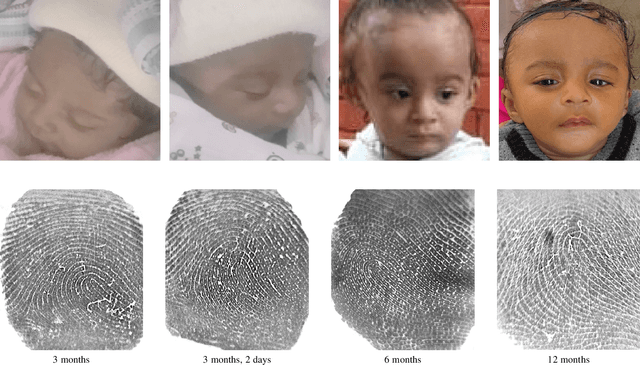
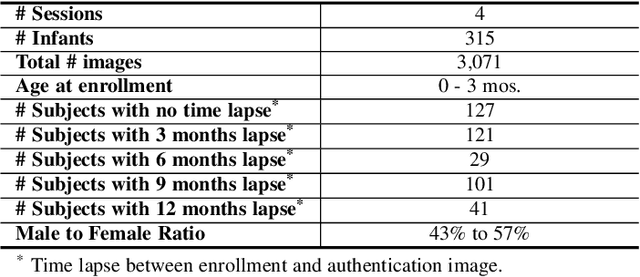

Abstract:In many of the least developed and developing countries, a multitude of infants continue to suffer and die from vaccine-preventable diseases and malnutrition. Lamentably, the lack of official identification documentation makes it exceedingly difficult to track which infants have been vaccinated and which infants have received nutritional supplements. Answering these questions could prevent this infant suffering and premature death around the world. To that end, we propose Infant-Prints, an end-to-end, low-cost, infant fingerprint recognition system. Infant-Prints is comprised of our (i) custom built, compact, low-cost (85 USD), high-resolution (1,900 ppi), ergonomic fingerprint reader, and (ii) high-resolution infant fingerprint matcher. To evaluate the efficacy of Infant-Prints, we collected a longitudinal infant fingerprint database captured in 4 different sessions over a 12-month time span (December 2018 to January 2020), from 315 infants at the Saran Ashram Hospital, a charitable hospital in Dayalbagh, Agra, India. Our experimental results demonstrate, for the first time, that Infant-Prints can deliver accurate and reliable recognition (over time) of infants enrolled between the ages of 2-3 months, in time for effective delivery of vaccinations, healthcare, and nutritional supplements (TAR=95.2% @ FAR = 1.0% for infants aged 8-16 weeks at enrollment and authenticated 3 months later).
White-Box Evaluation of Fingerprint Recognition Systems
Aug 01, 2020



Abstract:Typical evaluations of fingerprint recognition systems consist of end-to-end black-box evaluations, which assess performance in terms of overall identification or authentication accuracy. However, these black-box tests of system performance do not reveal insights into the performance of the individual modules, including image acquisition, feature extraction, and matching. On the other hand, white-box evaluations, the topic of this paper, measure the individual performance of each constituent module in isolation. While a few studies have conducted white-box evaluations of the fingerprint reader, feature extractor, and matching components, no existing study has provided a full system, white-box analysis of the uncertainty introduced at each stage of a fingerprint recognition system. In this work, we extend previous white-box evaluations of fingerprint recognition system components and provide a unified, in-depth analysis of fingerprint recognition system performance based on the aggregated white-box evaluation results. In particular, we analyze the uncertainty introduced at each stage of the fingerprint recognition system due to adverse capture conditions (i.e., varying illumination, moisture, and pressure) at the time of acquisition. Our experiments show that a system that performs better overall, in terms of black-box recognition performance, does not necessarily perform best at each module in the fingerprint recognition system pipeline, which can only be seen with white-box analysis of each sub-module. Findings such as these enable researchers to better focus their efforts in improving fingerprint recognition systems.
HERS: Homomorphically Encrypted Representation Search
Mar 27, 2020



Abstract:We present a method to search for a probe (or query) image representation against a large gallery in the encrypted domain. We require that the probe and gallery images be represented in terms of a fixed-length representation, which is typical for representations obtained from learned networks. Our encryption scheme is agnostic to how the fixed-length representation is obtained and can, therefore, be applied to any fixed-length representation in any application domain. Our method, dubbed HERS (Homomorphically Encrypted Representation Search), operates by (i) compressing the representation towards its estimated intrinsic dimensionality, (ii) encrypting the compressed representation using the proposed fully homomorphic encryption scheme, and (iii) searching against a gallery of encrypted representations directly in the encrypted domain, without decrypting them, and with minimal loss of accuracy. Numerical results on large galleries of face, fingerprint, and object datasets such as ImageNet show that, for the first time, accurate and fast image search within the encrypted domain is feasible at scale (296 seconds; 46x speedup over state-of-the-art for face search against a background of 1 million).
Fingerprint Synthesis: Search with 100 Million Prints
Dec 16, 2019



Abstract:Evaluation of large-scale fingerprint search algorithms has been limited due to lack of publicly available datasets. A solution to this problem is to synthesize a dataset of fingerprints with characteristics similar to those of real fingerprints. We propose a Generative Adversarial Network (GAN) to synthesize a fingerprint dataset consisting of 100 million fingerprint images. In comparison to published methods, our approach incorporates an identity loss which guides the generator to synthesize a diverse set of fingerprints corresponding to more distinct identities. To demonstrate that the characteristics of our synthesized fingerprints are similar to those of real fingerprints, we show that (i) the NFIQ quality value distribution of the synthetic fingerprints follows the corresponding distribution of real fingerprints and (ii) the synthetic fingerprints are more distinct than existing synthetic fingerprints (and more closely align with the distinctiveness of real fingerprints). We use our synthesis algorithm to generate 100 million fingerprint images in 17.5 hours on 100 Tesla K80 GPUs when executed in parallel. Finally, we report for the first time in open literature, search accuracy (DeepPrint rank-1 accuracy of 91.4%) against a gallery of 100 million fingerprint images (using 2,000 NIST SD4 rolled prints as the queries).
White-Box Evaluation of Fingerprint Matchers
Sep 23, 2019



Abstract:Prevailing evaluations of fingerprint recognition systems have been performed as end-to-end black-box tests of fingerprint identification or verification accuracy. However, performance of the end-to-end system is subject to errors arising in any of the constituent modules, including: fingerprint reader, preprocessing, feature extraction, and matching. While a few studies have conducted white-box testing of the fingerprint reader and feature extraction modules of fingerprint recognition systems, little work has been devoted towards white-box evaluations of the fingerprint matching sub-module. We report results of a controlled, white-box evaluation of one open-source and two commercial-off-the-shelf (COTS) state-of-the-art minutiae-based matchers in terms of their robustness against controlled perturbations (random noise, and non-linear distortions) introduced into the input minutiae feature sets. Experiments were conducted on 10,000 synthetically generated fingerprints. Our white-box evaluations show performance comparisons between different minutiae-based matchers in the presence of various perturbations and non-linear distortion, which were not previously shown with black-box tests. Furthermore, our white-box evaluations reveal that the performance of fingerprint minutiae matchers are more susceptible to non-linear distortion and missing minutiae than spurious minutiae and small positional displacements of the minutiae locations. The measurement uncertainty in fingerprint matching is also developed.
 Add to Chrome
Add to Chrome Add to Firefox
Add to Firefox Add to Edge
Add to Edge